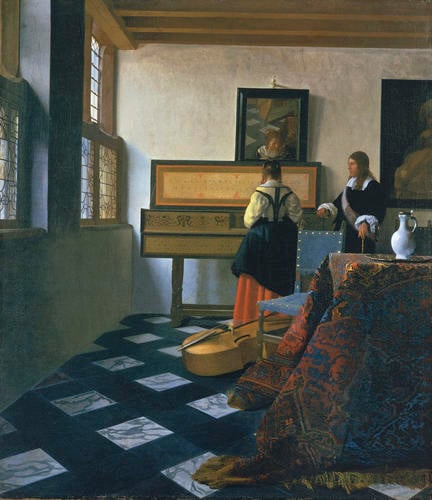-
1 of 253523 objects
Lady at the Virginals with a Gentleman early 1660s
Oil on canvas | 74.1 x 64.6 cm (support, canvas/panel/stretcher external) | RCIN 405346
-
A Lady at the Virginal with a Gentleman entered the Royal Collection in 1762 as a work by Frans van Mieris the Elder owing to a misreading of the signature. Indeed, the name of the artist was not correctly identified until 1866 by Théophile Thoré. During the late seventeenth century the picture had been in collections in Delft, Vermeer's home town, including that eventually sold on 16 May 1696 by Jacob Dissous which had twenty-one paintings by the artist - the largest group of such works assembled by a single individual. A lady at the virginal was subsequently acquired by the Venetian artist, Giovanni Antonio Pellegrini, in 1718 either in Amsterdam or The Hague. Pellegrini's collection was bought by Consul Joseph Smith, who in turn sold his own collection to George III. By such a route did one of the greatest Dutch pictures in the Royal Collection arrive and to a certain extent the initial oversight regarding its importance has been more than adequately compensated for by the amount of scholarly attention that it now receives.
Paintings by Vermeer - of which there are only around thirty-five - are difficult to date and any chronology has to be based on an interpretation of style and complexity of composition. A Lady at the Virginals was undoubtedly painted during the 1660s, but it is not possible to be more specific, although there is at present a consensus of c.1662-4. The composition is characterised by the rigorous use of perspective to draw the eye towards the back of the room where the figures are situated - the young woman rather surprisingly seen from the back. The viewer is at first more aware of the jutting corner of the table, the chair and the bass viol than of the figures themselves, whose privacy is thereby protected. The back of the room, dominated by the virginals comparable with those made by Andreas Ruckers the Elder, is like a grid of verticals and horizontals into which the figures are carefully locked. Light is admitted through the windows on the left and fills the room, casting only soft, subtle shadows. A striking feature of the composition in this part is the mirror on the wall where the slightly blurred reflections include the young woman's face, part of the table and the legs of an artist's easel. The implication of this glimpsed easel is that Vermeer shares the same space as the figures he is depicting, but as a result of this artifice he is also, like the viewer, standing outside that space. In fact, as Alpers has observed, Vermeer's composition is based on exclusion. Many of the elements, particularly at the back of the room, are seen only partially, as though indicating 'the appearance of the world as ungraspable'.
The inscription on the lid of the virginal, MUSICA LETITIAE CO[ME]S / MEDICINA DOLOR[IS], means 'Music is a companion in pleasure and a balm in sorrow.' It suggests that it is the relationship between the man and the young woman that is being explored by the artist, but what stage that relationship has reached is impossible to say. The fact that there are two musical instruments implies shared pleasures and a potential harmony, which is also indicated by the rapt expression on the man's face as he listens to the young woman or sings as she plays on the virginal. That some aspect of love is the presiding theme can be deduced not only from paintings by Vermeer's contemporaries, such as Metsu, but also by the presence in A Lady at the Virginal of the picture of Roman Charity (Cimon and Pero) by Dirck van Baburen on the wall in the background on the right. This is the story of how the imprisoned Cimon was nourished by his daughter Pero, symbolising the ideal of Christian charity both physically and spiritually. It is known that Vermeer's mother-in-law, Maria Thins, owned such a painting and Vermeer did use another painting by this artist in the background of two of his other pictures. The vase on the table is placed below Roman Charity and so with regard to that picture may be an additional correlative for the young people in the room.
The mood of the present interior by Vermeer is created as much by the careful selection of so few objects as by the confrontation of the two figures in whose plight, in the words of Lawrence Gowing, 'there rests, as gentle as the air itself, an allegory of liberty and bondage, an allegory, as the inscription informs us, of the pleasure and melancholy of love'.
Signed on the bottom of the frame of the painting on the extreme right: IVMeer (IVM in monogram)
The painting appears in Pyne's illustrated 'Royal Residences' of 1819, hanging over the mantle in the King's Closet at Windsor Castle (RCIN 922104).
Catalogue entry from Royal Treasures, A Golden Jubilee Celebration, London 2002Provenance
Jacob Dissius before 1696; acquired c.1718 by Giovanni Antonio Pellegrini, probably in the Low Countries; bought in 1742, possibly from Pellegrini's widow, by Joseph Smith, from whom bought by George III in 1762 (Dutch and Flemish list, no 91)
-
Creator(s)
Previously attributed to (artist)(nationality)Acquirer(s)
-
Medium and techniques
Oil on canvas
Measurements
74.1 x 64.6 cm (support, canvas/panel/stretcher external)
98.0 x 89.3 x 7.5 cm (frame, external)
Category
Object type(s)
Other number(s)
CW : White, C., 1982. The Dutch Pictures in the Collection of Her Majesty the Queen, Cambridge – CW 230Bibliographic reference(s)
Traces of Vermeer
Alternative title(s)
A Lady at the Virginals with a Gentleman, 'The Music Lesson'
